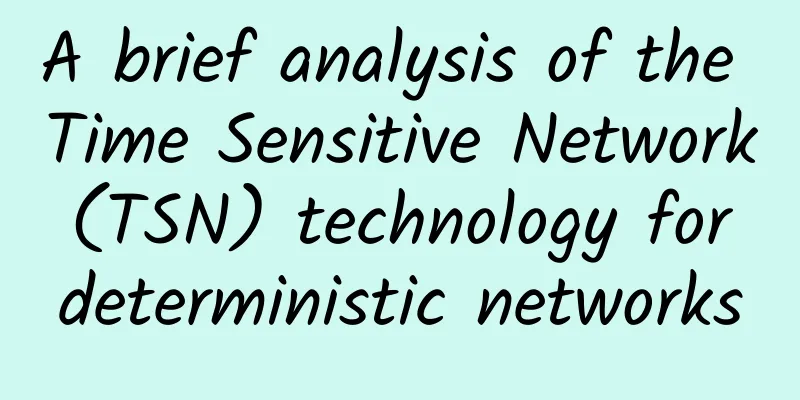A brief analysis of the Time Sensitive Network (TSN) technology for deterministic networks

|
Author: Lu Yingchuan, unit: China Mobile Smart Home Operation Center Labs GuideCompared with other deterministic network technologies, such as Flexible Ethernet (FlexE) working at layer 1.5 and Deterministic Network (DetNet) working at layer 3, TSN mainly solves the problem of deterministic guarantee in layer 2 networks. It achieves zero congestion and packet loss transmission through a series of protocol standards, provides low latency and jitter with upper bounds, and provides deterministic transmission guarantees for latency-sensitive traffic. The existing Ethernet technology was first proposed in 1973 and officially put into commercial use in 1982 (Ethernet V2). It quickly defeated the token ring and FDDI technologies of the same period and was gradually adopted by the world. Although relying on the quality of service (QoS) technology to classify and mark all data packets, it can achieve the purpose of forwarding according to different priorities under certain conditions. However, the characteristics of network serial transmission and the best effort forwarding mechanism make the delay, jitter and service quality of data uncontrollable during end-to-end transmission. Based on this, the IEEE 802.1 task group formulated the Audio Video Bridging (AVB) specification in 2005, which is a set of Ethernet protocols for real-time audio and video transmission. The task group was officially renamed Time Sensitive Network (TSN) in November 2012. At the same time, it became a new generation of network standards based on Ethernet, with real-time functions such as time synchronization and delay guarantee. It has gradually been widely used in industrial control, intelligent manufacturing and 5G. Part 01 Definition of TSNCompared with other deterministic network technologies, such as Flexible Ethernet (FlexE) working at layer 1.5 and Deterministic Network (DetNet) working at layer 3, TSN mainly solves the problem of deterministic guarantee in layer 2 networks. It achieves zero congestion and packet loss transmission through a series of protocol standards, provides low latency and jitter with upper bounds, and provides deterministic transmission guarantees for latency-sensitive traffic. Figure 1 TSN protocol layers TSN is a VLAN that complies with the IEEE802.1Q standard and inserts a 4-byte VLAN tag into a standard Ethernet frame. TSN defines different priority protocol levels for flows through the PCP (Priority Code Point) and VID (VLAN ID) in the VLAN tag [1].
Figure 2 TSN frame structure Part 02 TSN TechnologyIn order to achieve deterministic transmission in the local area network, time-sensitive networking (TSN) implements precise network time synchronization mechanism, flow shaping, classification and traffic scheduling mechanism of different priority traffic, as well as end-to-end, network switch configuration to provide systematic network configuration mechanism for services such as reserved bandwidth for time-sensitive data. Figure 3 TSN key technologies Figure 4 TSN protocol component set 2.1 Time SynchronizationTime synchronization is the foundation of TSN and the key to subsequent traffic scheduling based on time slots. TSN uses the IEEE 802.1AS protocol to achieve the purpose of clock synchronization for the entire network. This is a precise time protocol that ensures that the clocks of related network devices are consistent and does not need to be synchronized with the clocks in nature. This protocol is an extension of the precision time protocol (PTP) of IEEE 1588-2008, and proposes a generalized precision time protocol (gPTP). Global time synchronization is the basis for TSN to truly achieve the end-to-end deterministic delay and queue-free transmission requirements of communication flows. It is a further improvement of the Ethernet synchronization protocol, adding the synchronization of distributed networks, and using a two-way information channel to improve the accuracy of the transmission signal. At the same time, the updated and revised IEEE802.1 AS-REV protocol adds the ability to synchronize time for multiple time domains, which can quickly switch to other domains when the global clock in a domain fails. 2.2 Flow ControlTSN traffic control mainly involves traffic classification, traffic shaping, and traffic scheduling and preemption. The type and priority of the corresponding traffic are determined through the relevant attribute information of the VLAN tag in the frame; the identified TSN flow is shaped by speed limiting or temporary caching to control the traffic to be sent and received at a preset rate; through a certain scheduling algorithm and mechanism, the shaped or queued flow is scheduled to the output end and forwarded in the switch in the corresponding order, while the service quality requirements of various flow transmissions are guaranteed according to QoS. In this process, low-priority frame transmission is interrupted by inter-frame slicing to ensure the timely forwarding of high-priority flows, ultimately achieving the real-time and ultra-low latency requirements of high-priority frame transmission [2]. The main ones are CBS shaper (Credit-based Shaper, based on IEEE 802.1Qav), TAS shaper (Time-aware Shaper, based on IEEE 802.1Qbv), CQF shaper (Cyclic Queuing and Forwarding, based on 802.1Qch) and IEEE ATS shaper (Asynchronous Traffic Shaping, based on 802.1Qcr). 2.3 Network ConfigurationUsing the configuration model defined for time-sensitive networking (TSN) in the IEEE 802.1Qcc protocol, TSN can currently provide three different configuration models: fully centralized, hybrid, and fully distributed, according to specific needs. It can customize the configuration of the sender, receiver, and switches in the network, and provide services such as reserved bandwidth for subsequent time-sensitive data transmitted on this network. Part 03 Characteristics of TSNCompared with standard Ethernet, the most significant feature of TSN is its ability to ensure the determinism of data exchange. By determining in advance the transmission cycle of time-sensitive data flows (called scheduled traffic) and the size of data transmitted in each cycle, TSN can ensure that the data will be exchanged to the receiver at a certain time as long as the data sender sends the data as agreed [3]. Part 04 Application of TSNTSN guarantees the deterministic service quality of local area networks. With the integration of OT (operational technology), IT (information technology) and CT (communication technology), TSN can send periodic and non-periodic data streams in these integrated local area networks. With broad application prospects in the fields of Internet of Vehicles, industrial control, smart grid, 5G, etc., TSN networks will develop faster. 4.1 Industrial InternetTSN can effectively take into account the requirements of high-efficiency data transmission and high reliability in the industrial Internet of Things scenario, and effectively promote the integration of industrial OT systems and IT systems. At the same time, combined with the deterministic transmission technology of URLLC under 5G, existing industrial equipment such as sensors and actuators can be wirelessly connected to the TSN network, which can achieve flexible deployment and application without the restrictions of cable installation. The whole system can be more automated, reducing human intervention and dependence, and will continue to promote the evolution of the underlying architecture of the industrial Internet. 4.2 In-vehicle NetworkWith the development of automobile intelligence and automation, in-vehicle networks need to meet the requirements of advanced driver assistance systems (ADAS), intelligent on-board diagnostic systems (OBD), in-vehicle multimedia systems, and other types of in-vehicle systems for carrying and interconnection. Existing in-vehicle networks are still based on the coexistence of various buses, and media signals and control signals cannot be uniformly transmitted on the same link. Therefore, how to ensure that the requirements of various types of traffic for end-to-end transmission delay, jitter, packet loss rate, etc. are met under mixed flow conditions is the technical difficulty and question faced by in-vehicle networks. TSN can provide different degrees of end-to-end bounded delay guarantees and smaller jitter according to the different priorities of data traffic. In addition, the quality of service can be verified by theory. These characteristics can meet the development needs of in-vehicle networks and thus meet the application requirements of in-vehicle Ethernet [4]. References[1] Internet document, Understanding TSN in one article, https://www.sdnlab.com/25482.html. [2] SDNLAB, A Brief Analysis of TSN Time-Sensitive Network Technology, 2022.4. [3] Internet document, TNS exchange based on FAST, https://blog.csdn.net/m0_37537704/article/details/86747622. [4] Industrial Internet Alliance, Time-Sensitive Networking Industry White Paper, August 2020. |
<<: How to Make Ethernet Cable Longer
>>: Let you understand the MQTT protocol
Recommend
Cisco wins three employer awards for building cross-generational innovative talent strategies in the digital era
At the end of 2018, Cisco has won a series of emp...
Cisco released the IT Operations Readiness Index report, and Chinese enterprises' IT operations provide more value to their businesses
[Original article from 51CTO.com] Cisco recently ...
my country has built the world's largest 4G network
On January 6, the Ministry of Science and Technol...
5G has yet to bring innovation in connectivity pricing
It is reported that unlike its predecessor, 5G ha...
SiberDC: $1.3/month Türkiye VPS - dual core/1GB RAM/30G SSD/1Gbps unlimited traffic
SiberDC is a foreign merchant founded in 2011, he...
Quick Engine Acceleration - Sub-second Analysis of Billions of Data
As the digitalization process deepens, the value ...
FDCservers: XEN in Hong Kong/Japan/Singapore and other data centers, monthly payment starts from $1.98
The tribe has shared information about FDCservers...
Changting Technology's new product launch conference was held in Beijing to reconstruct a new network protection system
On July 14, Changting Technology, a provider of n...
Inventory: Three basic elements and five characteristics of the Industrial Internet
Three basic elements of the Industrial Internet S...
Borui Data passed the CMMI Level 5 assessment, the first in the domestic APM field
Recently, Borei Data passed the CMMI Level 5 asse...
Will Wi-Fi 7 be a revolution?
A Google search for “famous members of Generation...
DogYun: Hong Kong VPS monthly payment starts from 15 yuan, Australia/Korea/US VPS monthly payment starts from 20 yuan
When it comes to low-priced VPS, we first think o...
6 hot trends in IT recruiting, and 5 that are cooling down
A global pandemic, the resulting recession and na...
How to unleash greater potential of new infrastructure
Recently, several domestic mobile communication o...
A funny story about three handshakes and four waves: How to seize the opportunity when you meet a girl you like?
I have a friend, Xiao Long, who confided in me: H...









